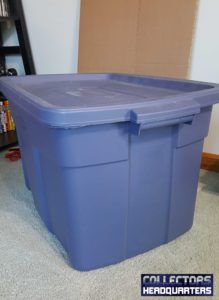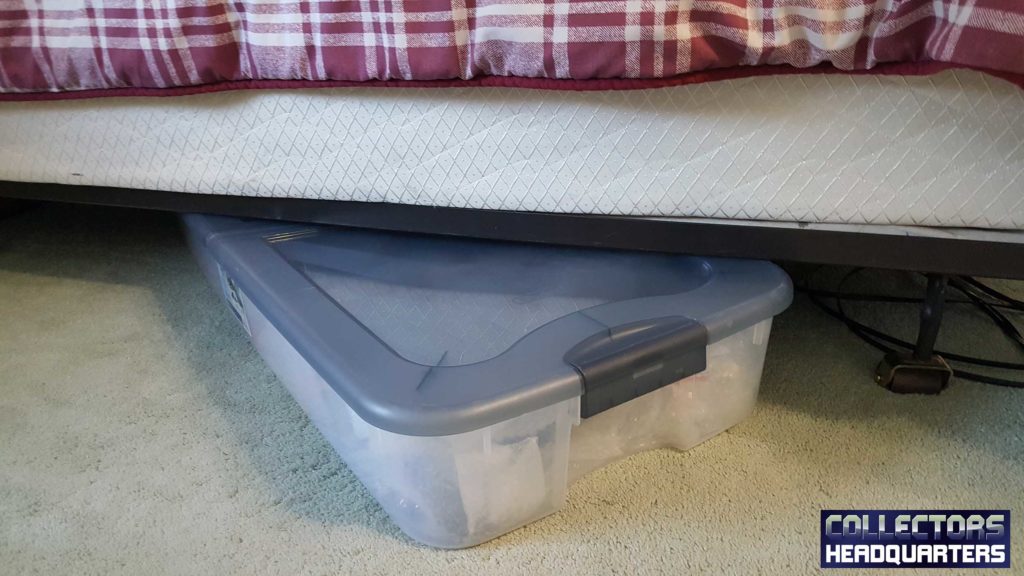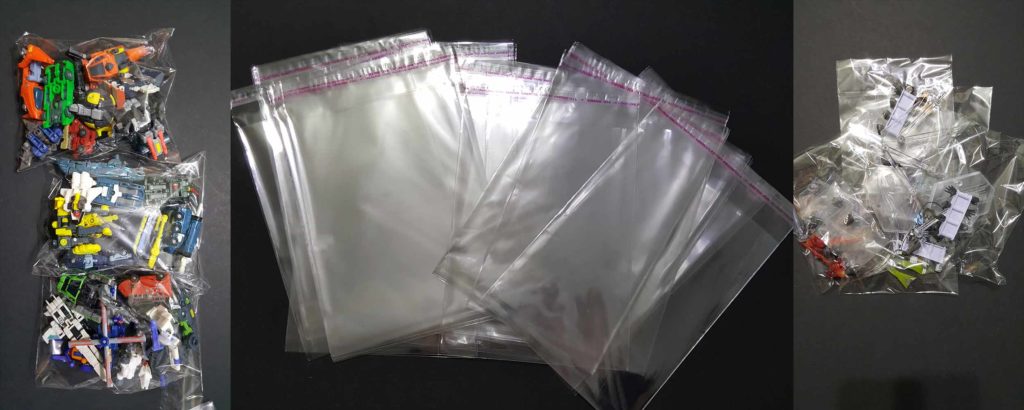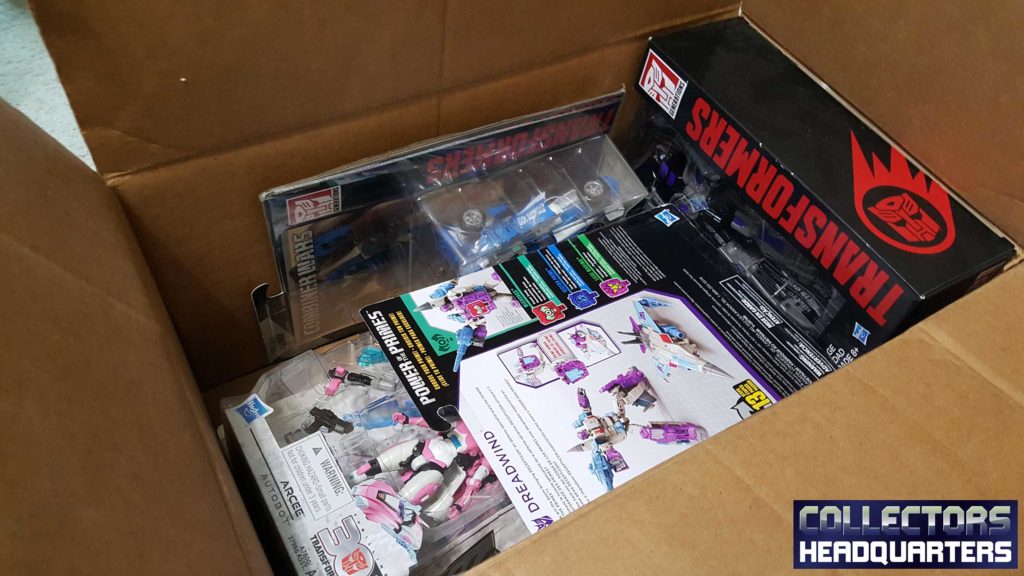There a comes a point where its time to take certain figures off of the display shelf and store them away. Whether it’s because you have run out of space or you simply want to display other figures instead. In short, you will likely need to pack certain figures away—potentially for long term storage. As with most aspects of maintaining an action figure collection, there are certain things that need to be taken into consideration.
Click here for a list of items that you may need when storing your action figures.
Things to Consider When Storing Your Action Figure Collection:
Types of Storage Units Available:
Are you going to use plastic tubs or cardboard boxes? Generally plastic tubs are a better option, because they are easier to stack and store and therefore are going to take up much less space. Plastic tubs also tend to be sturdier and able to hold more weight. Also, If you’re storing your figures in the basement, or somewhere that is prone to possible flooding, plastic tubs are a much better option as they are more likely to protect your figures from the intrusion of water.
Here are some options you may want to consider:
- 16.49L x 10.98W x 6.53H — can hold up to 12 quarts (6 tubs included)
- 18.13L x 12.25W x 7H — can hold up to 18 quarts (6 tubs included)
- 16.25L x 13W x 12.125H — can hold up to 31 quarts (4 tubs included)
If the climate you live in tends to be humid and you’re worried about the plastic containers retaining moisture inside, you can always poke hole in the sides or the lid of the tub for air circulation.
Where Should You Store Your Action Figures:
Many will be tempted to store their action figure collection in the attic, garage, or basement since there may be underutilized space there and it gets the tubs and boxes out of the way. These are not good places to store your figures in most cases because the temperature cannot be controlled. In the case of the attic and garage the temperature is likely going to be whatever it is outdoors. In the summer, your attic will likely get significantly hotter than it is outside during warmer days, which makes it one of the worst places to store your figures. Obviously there are exceptions: if your attic is finished, then it may be fine to store figures in there. In the case of the basement, the temperature is probably fine; however, basements do tend to be more humid than other rooms in the house. If you are going to store your figures in the basement, and your basement tends to have allot of moisture in the air, consider buying a dehumidifier:
With all things there are exceptions, but, in general, closets are a good place to store your figures. The temperature tends to remain more consistent than in the rest of the house and can be regulated better. Closets are also dark, so UV rays won’t be an issue if you choose to store your figures in clear plastic tubs. And, finally, you can keep the tubs out of the way by storing them in a closet. An issue, of course, is that you may run out of closet space and/or have to relocated items from your closet to make room for your figures. Though, with the preservation of your figures being at stake, this is probably a good trade off.
What Temperature Should You Keep the Room At:
This is one of the most important ones. Generally, its probably best to store your figures in a room where the temperature doesn’t fluctuate that much and remains between 55- and 70-degrees Fahrenheit. Extreme temperatures are not good for your figures—especially extreme heat. Extreme heat will speed up the process of thermal oxidation—a chemical reaction caused by oxygen reacting with the polymers in the plastic. This process is partially responsible for certain figures discoloring over time and/or becoming brittle. Extreme heat can also cause your figures to warp and become sticky from the plasticizers reacting to the environmental conditions (more on this later).
While extreme cold is not necessarily good for your action figures, its not going to ruin them as quickly as the heat will. Storing your figures in the extreme cold for a prolonged period of time will, however, cause them to be become brittle eventually.
How Much Space Do You Need To Store Your Action Figure Collection:
As I’ve just mentioned, when storing a large collection, you have to consider the space you have available. You likely don’t want a large portion of floor space getting occupied by your tubs of toys. Again, stackable plastic tubs are a good solution to this problem. Another option is to go with long tubs that aren’t very high like this for example. These you can slide under your bed or dresser or somewhere else out of the way. Here are some options you might consider:
- 32. 50L x 17. 75W x 6. 50H — can hold up to 50 quarts
- 24L x 16.25W x 6H — can hold up to 28 quarts (pack of 2)

Should You Store Your Figures in Air Tight Containers or Bags:
Many assume that its best to seal your action figures in air-tight bags in order to avoid exposure to oxygen, since oxygen speeds up the process of thermal oxidation. This is a double-edged sword. Sealing your figures may slow down the thermal oxidation and therefore slow down potential discoloration, however, if your action figures are not exposed to air for a very long period of time, you could find your figures with a thin layer of sticky film over them. This occurs when the plasticizers in the plastic are not allowed to evaporate naturally. These plasticizers are in the plastic mixture in order to keep the plastic soft and not brittle. Without the plasticizer, our action figures would break much more easily.
This being said, your sealed action figures are not going to become sticky over night. It takes some time, and should be more of a concern for people who never remove their figures from the original packaging. If you do want to store your figures in air tight bags, use polypropylene bags, and just take your figures out to breathe every so often. I’ll discuss polypropylene bags in more detail shortly.
Keep Your Action Figures Away From UV Rays:
UV radiation from the sun or from certain lights (like florescent lights) is one of the worst possible things for your action figures. UV rays can cause discoloration which often means that white figures will turn that ugly yellowish brown color. This is due to a process called photodegradation brought about by UV rays reacting with the chemicals in the plastic that that the figures are made of.
If you’re storing your action figures in clear plastic tubs, keep them out of direct sunlight, and try to make sure they’re not under florescent lights often. I don’t actually know if the clear plastic tubs will protect the figures from the UV rays or not, but I would be on the safe side and store them somewhere out of reach of those nasty UV rays.
What Packing Material Should You Use:
Generally, when you’re filling tubs with action figures for storage, you want some kind of packing material to keep the figures separated from one another to avoid damage. Bubble wrap or packing paper are good options for this. For me, I wrap the figures in bubble wrap and stack them in the tub. I don’t wrap them too tightly so they have room to breath.

If you’re concerned about the effects of thermal oxidation and want to ensure that your figures are sealed away, perhaps you should buy some polypropylene bags. Polypropylene bags are acid free and are used by museums for archival purposes. If you want to seal you’re figures or accessories in plastic bags to avoid too much exposure to the air, go with these.
Don’t use sandwich bags! Those are meant to store food for a short period of time and are not ideal for long term storage of action figures or other collectibles. The acids in the plastic of these bags will likely start to eat away at the paint on your action figures over time as well as damaging the plastic itself eventually.
Keeping an Inventory of Your Figures in Storage:
Once you start storing your action figures away, you want to have some way of keeping track of where everything is located. Labeling your tubs/boxes is good way of keeping track of things. What I personally recommend doing is keeping an inventory of all the figures in your collection using spreadsheet software such as Microsoft Excel. Include a column in the spreadsheet for “Storage Unit” and enter in the number of the tub or box that the figure is being stored in. Label the tubs accordingly. I go into more detail about this here.
Take Out the Batteries:
Remove the batteries before storing them. Just do it. Batteries corrode. Actually, for figures that have batteries, I recommend removing the batteries as soon as you get the figure, unless you really enjoy the lights and sound effects. It is far too easy to forget about the batteries in a figure and then years later find that they have corroded. I’m speaking from experience here. Do yourself a favor: Stop putting it off, and take out the batteries!
Storing Action Figures in Their Packaging:
For unopened action figures, pretty much everything I’ve just talked about still applies. Obviously one of the key differences here is space. When you’re storing unopened figures, they are just going to take up more space. That means more tubs or boxes will probably be needed. Humidity is also going to be a bigger factor with action figure packaging because of the effect moist air will have on the cardboard.
The Types of Figures You’re Storing Will Be a Factor:
The way you choose to store your action figure collection will, in part, be base on the types of action figures you’re storing. Some action figures (especially older ones) might have parts made of metal, some have chrome finishes that may start to peal under certain environmental conditions, some have batteries that need to be removed, some are very large and heavy, some have allot of accessories—I could go on and on. For some of these, you’re going to need to use some common sense and your own judgment. What I’ve written here should apply to most figures though and should provide you with a great starting point.
Click here for a list of items that you may need when storing your action figures.
Click here for my post on storing action figure pieces and parts.
Related Articles
How to Store Transformers Figures
What separates Transformers from other action figures is the transforming factor. This allows for some good flexibility when it comes to prepping the figures for storage. You can choose to store your Transformers in robot mode or the alternate mode (or somewhere in...
How to Store Your Funko Pops
Do you have a Funko Pop collection that has gotten so large that you no longer have enough space to display all of them? There comes a point in every truly dedicated collector’s life when they have accumulated so much, that it becomes difficult to figure out what to...
How to Store Action Figure Parts and Accessories
So, if you’re reading this post, my assumption is that you are trying to find a better way to store and organize your action figure parts and accessories. Accessories could be weapons, additional gear, jetpacks, missiles and other projectiles—basically anything that...
Can Dust Damage Action Figures and Collectibles?
Answer: No. At worst, dust just makes your figures look dirty; however, that’s usually the worst thing it can do. Dust does not damage your figures. If you're looking for some items to use for cleaning the dust off your figures, I have listed some resources here. How...


